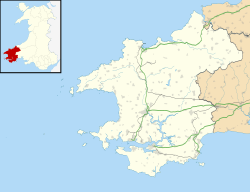History
An early mention of the parish was about 1200, when Gerald of Wales recorded a chapel there, subordinate to Nash parish. The Manor of Upton merged with that of Nash under the 14th century Malefants, who had built the castle probably in the 13th century. [3] By the 16th century, the Bowen family owned the manor. [4] The parish is marked on a 1578 parish map of the county. [5]
In the second half of the 18th century, Captain John Tasker of the East India Company purchased Upton Castle; among the eventual beneficiaries after his death were members of the Evans family. [6] In 1833, Lewis, in his Topographical Dictionary of Wales, recorded that the parish was occupied by a single family of six inhabitants. At that time Nash-cum-Upton was a rectory in the non-adjoining Nash parish, to the south. Lewis described the former inhabitants of the castle and its dependencies as Maliphant (sic), then Bowen, then Evans. [2] In 1872, Upton was described as a hamlet in Nash parish, with a population of 24 in three houses. It covered an area of 435 acres (176 ha), 105 acres (42 ha) of which were water. [7]
Tasker Evans sold to Stanley Neale in 1927. The asking price was £9,100. [8]
In 2004, Pembrokeshire Coast National Park said they would discontinue the upkeep of the gardens. In 2006 the estate was sold. [8] In 2012, Channel 4's Time Team carried out an archaeological evaluation of the castle and chapel. Their evidence suggested the chapel was 11th or 12th century, subsequently altered. [3]
Modern maps show only Upton Farm, Upton Castle Gardens and the ruins of Upton Castle and Chapel. [9]
This page is based on this
Wikipedia article Text is available under the
CC BY-SA 4.0 license; additional terms may apply.
Images, videos and audio are available under their respective licenses.


